Artificial Intelligence Applications for Smart and Sustainable Mobility as a Service Concept: A Systematic Literature Review
Abstract
1. Introduction
- RQ1: What is the relationship between MaaS level of integration, and the methods of AI used?
- RQ2: What specific AI algorithms and technologies are commonly employed in MaaS systems?
- RQ3: What practical applications do AI techniques have within the Mobility as a Service (MaaS) ecosystem?
2. Search Method and a First Glance at Publications
2.1. Search Method
2.2. First Glance at Publications
3. Classification of Artificial Intelligence Applications by MaaS Level of Integration
3.1. Basic Integration Level
3.2. Intermediate Integration Level
3.3. Advanced Integration Level
- Overemphasis on technical performance: Many studies validate models on accuracy or efficiency but pay limited attention to long-term user adoption or cross-platform interoperability.
- Data dependency: Most approaches rely on high-quality, large-scale datasets, yet few address challenges of data sparsity, bias, or privacy protection, which are critical for scalable MaaS deployment.
- Limited integration with governance: Although AI models demonstrate real-time adaptability, relatively little work connects these systems to policy, equity, or regulatory considerations, which are essential for sustainable adoption.
- Generalizability: AI models trained on specific cities or services often lack transferability to different contexts, raising concerns about broader applicability.
3.4. Full Integration Level
4. Discussion
4.1. General Insights
4.2. Machine Learning Applications
4.3. Deep Learning Applications
4.4. Other Techniques
5. Future Directions and Recommendations
6. Conclusions
Supplementary Materials
Author Contributions
Funding
Conflicts of Interest
References
- Bousouf, A.; Rouky, N.; Benmoussa, O.; Fri, M. Behavioral Modeling and Prediction in Urban Multimodal Transport: Current Techniques and Future Trends. In Proceedings of the 2023 7th IEEE Congress on Information Science and Technology (CiSt), Agadir-Essaouira, Morocco, 16–22 December 2023; pp. 355–360. [Google Scholar] [CrossRef]
- Rouky, N.; Bousouf, A.; Benmoussa, O.; Fri, M. A spatiotemporal analysis of traffic congestion patterns using clustering algorithms: A case study of Casablanca. Decis. Anal. J. 2024, 10, 100404. [Google Scholar] [CrossRef]
- Rizzi, L.I.; De La Maza, C. The external costs of private versus public road transport in the Metropolitan Area of Santiago, Chile. Transp. Res. Part A Policy Pract. 2017, 98, 123–140. [Google Scholar] [CrossRef]
- Mitropoulos, L.; Kortsari, A.; Mizaras, V.; Ayfantopoulou, G. Mobility as a Service (MaaS) Planning and Implementation: Challenges and Lessons Learned. Future Transp. 2023, 3, 498–518. [Google Scholar] [CrossRef]
- Tomaino, G.; Teow, J.; Carmon, Z.; Lee, L.; Ben-Akiva, M.; Chen, C.; Leong, W.Y.; Li, S.; Yang, N.; Zhao, J. Mobility as a service (MaaS): The importance of transportation psychology. Mark. Lett. 2020, 31, 419–428. [Google Scholar] [CrossRef]
- Jittrapirom, P.; Caiati, V.; Feneri, A.-M.; Ebrahimigharehbaghi, S.; González, M.J.A.; Narayan, J. Mobility as a Service: A Critical Review of Definitions, Assessments of Schemes, and Key Challenges. Urban Plan. 2017, 2, 13–25. [Google Scholar] [CrossRef]
- Kamargianni, M.; Li, W.; Matyas, M.; Schäfer, A. A Critical Review of New Mobility Services for Urban Transport. Transp. Res. Procedia 2016, 14, 3294–3303. [Google Scholar] [CrossRef]
- Mulley, C. Mobility as a Services (MaaS)—Does it have critical mass? Transp. Rev. 2017, 37, 247–251. [Google Scholar] [CrossRef]
- Utriainen, R.; Pöllänen, M. Review on mobility as a service in scientific publications. Res. Transp. Bus. Manag. 2018, 27, 15–23. [Google Scholar] [CrossRef]
- Maas, B. Literature Review of Mobility as a Service. Sustainability 2022, 14, 8962. [Google Scholar] [CrossRef]
- Durand; Harms, L.; Hoogendoorn-Lanser, S.; Zijlstra, T. Mobility-as-a-Service and Changes in Travel Preferences and Travel Behaviour: A Literature Review; Ministry of Infrastructure and Water Management: Hague, The Netherlands, 2018. [Google Scholar] [CrossRef]
- Wittstock, R.; Teuteberg, F. Sustainability impacts of mobility as a service: A scoping study for technology assessment. In Progress in Life Cycle Assessment 2018; Springer: Cham, Switzerland, 2019; pp. 61–74. [Google Scholar]
- Kriswardhana, W.; Esztergár-Kiss, D. A systematic literature review of Mobility as a Service: Examining the socio-technical factors in MaaS adoption and bundling packages. Travel Behav. Soc. 2023, 31, 232–243. [Google Scholar] [CrossRef]
- Page, M.J.; McKenzie, J.E.; Bossuyt, P.M.; Boutron, I.; Hoffmann, T.C.; Mulrow, C.D.; Shamseer, L.; Tetzlaff, J.M.; Akl, E.A.; Brennan, S.E.; et al. The PRISMA 2020 statement: An updated guideline for reporting systematic reviews. BMJ 2021, 372, 71. [Google Scholar] [CrossRef]
- Jnr, B.A.; Petersen, S.A.; Ahlers, D.; Krogstie, J. Big data driven multi-tier architecture for electric mobility as a service in smart cities. Int. J. Energy Sect. Manag. 2020, 14, 1023–1047. [Google Scholar] [CrossRef]
- Malik, F.A.; Dala, L.; Khalid, M.; Busawon, K. Intelligent Real-Time Modelling of Rider Personal Attributes for Safe Last-Mile Delivery to Provide Mobility as a Service. Appl. Sci. 2022, 12, 10643. [Google Scholar] [CrossRef]
- Cohen, T.; Jones, P. Technological advances relevant to transport–understanding what drives them. Transp. Res. Part A Policy Pract. 2020, 135, 80–95. [Google Scholar] [CrossRef]
- Panichpapiboon, S.; Khunsri, K. A Big Data Analysis on Urban Mobility: Case of Bangkok. IEEE Access 2022, 10, 44400–44412. [Google Scholar] [CrossRef]
- Longhi, L.; Nanni, M. Car telematics big data analytics for insurance and innovative mobility services. J. Ambient. Intell. Humaniz. Comput. 2019, 11, 3989–3999. [Google Scholar] [CrossRef]
- Sun, L.; Song, R. Improving Efficiency in Congested Traffic Networks: Pareto-Improving Reservations through Agent-Based Timetabling. Sustainability 2022, 14, 2211. [Google Scholar] [CrossRef]
- Tempelmeier, N.; Dietze, S.; Demidova, E. Crosstown traffic–supervised prediction of impact of planned special events on urban traffic. GeoInformatica 2020, 24, 339–370. [Google Scholar] [CrossRef]
- Tu, D.; Yun, L.; Chen, L.; Yang, Y.; Zeng, Q.; Chen, L.; Wu, C.-H. Modeling of Mobility as a Service (MaaS) Collaborative Dispatching System of Railway Passenger Transport Hub Based on Neural Network Algorithm. Wirel. Commun. Mob. Comput. 2022, 2022, 1288624. [Google Scholar] [CrossRef]
- Yoon, G.; Chow, J.Y. Unlimited-ride bike-share pass pricing revenue management for casual riders using only public data. Int. J. Transp. Sci. Technol. 2020, 9, 159–169. [Google Scholar] [CrossRef]
- Vitetta, A. Sustainable Mobility as a Service: Framework and Transport System Models. Information 2022, 13, 346. [Google Scholar] [CrossRef]
- Alsaleh, N.; Farooq, B. Interpretable data-driven demand modelling for on-demand transit services. Transp. Res. Part A Policy Pract. 2021, 154, 1–22. [Google Scholar] [CrossRef]
- Yang, S.; Wu, J.; Sun, H.; Qu, Y.; Wang, D.Z. Integrated optimization of pricing and relocation in the competitive carsharing market: A multi-leader-follower game model. Transp. Res. Part C Emerg. Technol. 2022, 138, 103613. [Google Scholar] [CrossRef]
- Huttel, F.B.; Peled, I.; Rodrigues, F.; Pereira, F.C. Modeling Censored Mobility Demand Through Censored Quantile Regression Neural Networks. IEEE Trans. Intell. Transp. Syst. 2022, 23, 21753–21765. [Google Scholar] [CrossRef]
- You, L.; He, J.; Wang, W.; Cai, M. Autonomous Transportation Systems and Services Enabled by the Next-Generation Network. IEEE Netw. 2022, 36, 66–72. [Google Scholar] [CrossRef]
- Kong, Q.; Lu, R.; Yin, F.; Cui, S. Blockchain-Based Privacy-Preserving Driver Monitoring for MaaS in the Vehicular IoT. IEEE Trans. Veh. Technol. 2021, 70, 3788–3799. [Google Scholar] [CrossRef]
- Cao, Y.; Song, H.; Kaiwartya, O.; Zhou, B.; Zhuang, Y.; Cao, Y.; Zhang, X. Mobile Edge Computing for Big-Data-Enabled Electric Vehicle Charging. IEEE Commun. Mag. 2018, 56, 150–156. [Google Scholar] [CrossRef]
- Li, X.; Xu, Y.; Chen, Q.; Wang, L.; Zhang, X.; Shi, W. Short-Term Forecast of Bicycle Usage in Bike Sharing Systems: A Spatial-Temporal Memory Network. IEEE Trans. Intell. Transp. Syst. 2022, 23, 10923–10934. [Google Scholar] [CrossRef]
- Chu, K.-F.; Guo, W. Deep reinforcement learning of passenger behavior in multimodal journey planning with proportional fairness. Neural Comput. Appl. 2023, 35, 20221–20240. [Google Scholar] [CrossRef]
- Luo, M.; Du, B.; Klemmer, K.; Zhu, H.; Wen, H. Deployment Optimization for Shared e-Mobility Systems With Multi-Agent Deep Neural Search. arXiv 2021. [Google Scholar] [CrossRef]
- Ding, X.; Qi, Q.; Jian, S.; Yang, H. Mechanism design for Mobility-as-a-Service platform considering travelers’ strategic behavior and multidimensional requirements. Transp. Res. Part B Methodol. 2023, 173, 1–30. [Google Scholar] [CrossRef]
- Motoharu, M.; Noritoshi, N. Activities on Multimodal MaaS to Solve the First Mile/Last Mile Problem—NTT DOCOMO’s Next-generation Mobility Service. NTT Tech. Rev. 2021, 19, 17–21. [Google Scholar]
- Esztergár-Kiss, D. Transportation Research Challenges Based on the Analysis of EU Projects. Promet Traffic Transp. 2023, 35, 446–461. [Google Scholar] [CrossRef]
- Park, H.; Hwang, S. Demand forecasting of micro mobility using a gated recurrent unit. Int. J. Sustain. Build. Technol. Urban Dev. 2021, 12, 170–185. [Google Scholar] [CrossRef]
- Fabiani, F.; Simonetto, A.; Goulart, P.J. Personalized Incentives as Feedback Design in Generalized Nash Equilibrium Problems. IEEE Trans. Autom. Control. 2022, 68, 7724–7739. [Google Scholar] [CrossRef]
- Phithakkitnukooon, S.; Patanukhom, K.; Demissie, M.G. Predicting Spatiotemporal Demand of Dockless E-Scooter Sharing Services with a Masked Fully Convolutional Network. ISPRS Int. J. Geo-Inf. 2021, 10, 773. [Google Scholar] [CrossRef]
- Jian, W.; Chen, K.; He, J.; Wu, S.; Li, H.; Cai, M. A Federated Personal Mobility Service in Autonomous Transportation Systems. Mathematics 2023, 11, 2693. [Google Scholar] [CrossRef]
- Wang, R.; Chen, F.; Liu, X.; Liu, X.; Li, Z.; Zhu, Y. A Matching Model for Door-to-Door Multimodal Transit by Integrating Taxi-Sharing and Subways. ISPRS Int. J. Geo-Inf. 2021, 10, 469. [Google Scholar] [CrossRef]
- Liang, Y.; Lan, C.; Dan, T.; Qiaoqiong, Z.; Yue, Y.; Lin, C. Research on supply and demand matching model of transportation modes in MaaS system of integrated passenger transport hub based on deep learning. Soft Comput. 2023, 27, 5973–5983. [Google Scholar] [CrossRef]
- Wang, X.; Cheng, Z.; Trépanier, M.; Sun, L. Modeling bike-sharing demand using a regression model with spatially varying coefficients. J. Transp. Geogr. 2021, 93, 103059. [Google Scholar] [CrossRef]
- Martin, H.; Wiedemann, N.; Reck, D.J.; Raubal, M. Graph-based mobility profiling. Comput. Environ. Urban Syst. 2023, 100, 101910. [Google Scholar] [CrossRef]
- Aman, J.J.C.; Smith-Colin, J. Application of crowdsourced data to infer user satisfaction with Mobility as a Service (MaaS). Transp. Res. Interdiscip. Perspect. 2022, 15, 100672. [Google Scholar] [CrossRef]
- Rajabi, E.; Nowaczyk, S.; Pashami, S.; Bergquist, M.; Ebby, G.S.; Wajid, S. A Knowledge-Based AI Framework for Mobility as a Service. Sustainability 2023, 15, 2717. [Google Scholar] [CrossRef]
- Boonjubut, K.; Hasegawa, H. Accuracy of Hourly Demand Forecasting of Micro Mobility for Effective Rebalancing Strategies. Manag. Syst. Prod. Eng. 2022, 30, 246–252. [Google Scholar] [CrossRef]
- Servou, E.; Behrendt, F.; Horst, M. Data, AI and governance in MaaS—Leading to sustainable mobility? Transp. Res. Interdiscip. Perspect. 2023, 19, 100806. [Google Scholar] [CrossRef]
- Cheng, Z.; Rashidi, T.H.; Jian, S.; Maghrebi, M.; Waller, S.T.; Dixit, V. A Spatio-Temporal autocorrelation model for designing a carshare system using historical heterogeneous Data: Policy suggestion. Transp. Res. Part C Emerg. Technol. 2022, 141, 103758. [Google Scholar] [CrossRef]
- Turno, F.M.; Yatskiv, I. Mobility-as-a-Service: Literature and Tools Review with a Focus on Personalization. Transport 2023, 38, 243–262. [Google Scholar] [CrossRef]
- Choi, H.; Park, S.Y.; Moon, H. The shared mobility services ban in South Korea: Consumer preferences and social opportunity cost. Travel Behav. Soc. 2022, 28, 214–226. [Google Scholar] [CrossRef]
- Zhang, P.; Liu, S.; Shi, J.; Chen, L.; Chen, S.; Gao, J.; Jiang, H. Route planning using divide-and-conquer: A GAT enhanced insertion transformer approach. Transp. Res. Part E Logist. Transp. Rev. 2023, 176, 103176. [Google Scholar] [CrossRef]
- Cokyasar, T.; de Souza, F.; Auld, J.; Verbas, O. Dynamic Ride-Matching for Large-Scale Transportation Systems. Transp. Res. Rec. 2022, 2676, 172–182. [Google Scholar] [CrossRef]
- Zou, W.; Wu, L.; Chang, Y.; Niu, Q. Is Ride-Hailing an Effective Tool for Improving Transportation Services in Suburban New Towns in China? Evidence from Wuhan Unicom Users’ Mobile Phone Usage Big Data. ISPRS Int. J. Geo-Inf. 2023, 12, 299. [Google Scholar] [CrossRef]
- Cuomo, M.T.; Colosimo, I.; Celsi, L.R.; Ferulano, R.; Festa, G.; La Rocca, M. Enhancing Traveller Experience in Integrated Mobility Services Via Big Social Data Analytics. Technol. Forecast. Soc. Chang. 2022, 176, 121460. [Google Scholar] [CrossRef]
- Chu, K.-F.; Guo, W. Privacy-Preserving Federated Deep Reinforcement Learning for Mobility-as-a-Service. IEEE Trans. Intell. Transp. Syst. 2024, 25, 1882–1896. [Google Scholar] [CrossRef]
- Duan, S.X.; Tay, R.; Molla, A.; Deng, H. Predicting Mobility as a Service (MaaS) use for different trip categories: An artificial neural network analysis. Transp. Res. Part A Policy Pract. 2022, 166, 135–149. [Google Scholar] [CrossRef]
- Ibrahim, H.A.; Qahtan, S.; Zaidan, A.A.; Deveci, M.; Hajiaghaei-Keshteli, M.; Mohammed, R.T.; Alamoodi, A. Sustainability in mobility for autonomous vehicles over smart city evaluation; using interval-valued fermatean fuzzy rough set-based decision-making model. Eng. Appl. Artif. Intell. 2024, 129, 107609. [Google Scholar] [CrossRef]
- Lee, J.; Kim, J.; González-Ramírez, R.G. Evaluation of Spatial and Temporal Performance of Deep Learning Models for Travel Demand Forecasting: Application to Bike-Sharing Demand Forecasting. J. Adv. Transp. 2022, 2022, 5934670. [Google Scholar] [CrossRef]
- Liu, J.; Wen, X.; Jian, S. Toward better equity: Analyzing travel patterns through a neural network approach in mobility-as-a-service. Transp. Policy 2024, 153, 110–126. [Google Scholar] [CrossRef]
- Lee, S.; Son, S.-O.; Park, J.; Park, J. Ensemble-Based Methodology to Identify Optimal Personal Mobility Service Areas Using Public Data. KSCE J. Civ. Eng. 2022, 26, 3150–3159. [Google Scholar] [CrossRef]
- Sun, G.; Boateng, G.O.; Liu, K.; Ayepah-Mensah, D.; Liu, G. Dynamic Pricing for Vehicle Dispatching in Mobility-as-a-Service Market via Multi-Agent Deep Reinforcement Learning. IEEE Trans. Veh. Technol. 2024, 73, 12010–12025. [Google Scholar] [CrossRef]
- Li, H.; Yuan, Z.; Novack, T.; Huang, W.; Zipf, A. Understanding spatiotemporal trip purposes of urban micro-mobility from the lens of dockless e-scooter sharing. Comput. Environ. Urban Syst. 2022, 96, 101848. [Google Scholar] [CrossRef]
- Donthu, N.; Kumar, S.; Mukherjee, D.; Pandey, N.; Lim, W.M. How to conduct a bibliometric analysis: An overview and guidelines. J. Bus. Res. 2021, 133, 285–296. [Google Scholar] [CrossRef]
- Aria, M.; Cuccurullo, C. bibliometrix: An R-tool for comprehensive science mapping analysis. J. Informetr. 2017, 11, 959–975. [Google Scholar] [CrossRef]
- Echchakoui, S. Why and how to merge Scopus and Web of Science during bibliometric analysis: The case of sales force literature from 1912 to 2019. J. Mark. Anal. 2020, 8, 165–184. [Google Scholar] [CrossRef]
- Gonçalves, L.; Silva, J.P.; Baltazar, S.; Barreto, L.; Amaral, A. Challenges and implications of Mobility as a Service (MaaS). In Implications of Mobility as a Service (MaaS) in Urban and Rural Environments: Emerging Research and Opportunities; IGI Global: Hershey, PA, USA, 2020; pp. 1–20. [Google Scholar]
- Sochor, J.; Arby, H.; Karlsson, I.M.; Sarasini, S. A topological approach to Mobility as a Service: A proposed tool for understanding requirements and effects, and for aiding the integration of societal goals. Res. Transp. Bus. Manag. 2018, 27, 3–14. [Google Scholar] [CrossRef]
- Samoili, S.; Cobo, M.L.; Gómez, E.; De Prato, G.; Martinez-Plumed, F.; Delipetrev, B. AI Watch. Defining Artificial Intelligence. Towards an Operational Definition and Taxonomy of Artificial Intelligence; European Commission: Brussels, Belgium, 2020. [Google Scholar]
- Pournader, M.; Ghaderi, H.; Hassanzadegan, A.; Fahimnia, B. Artificial intelligence applications in supply chain management. Int. J. Prod. Econ. 2021, 241, 108250. [Google Scholar] [CrossRef]
- Kamyab, H.; Khademi, T.; Chelliapan, S.; SaberiKamarposhti, M.; Rezania, S.; Yusuf, M.; Farajnezhad, M.; Abbas, M.; Jeon, B.H.; Ahn, Y. The latest innovative avenues for the utilization of artificial Intelligence and big data analytics in water resource management. Results Eng. 2023, 20, 101566. [Google Scholar] [CrossRef]
- Ho, C.Q.; Tirachini, A. Mobility-as-a-Service and the role of multimodality in the sustainability of urban mobility in developing and developed countries. Transp. Policy 2024, 145, 161–176. [Google Scholar] [CrossRef]
- Aritenang, A.F. The crucial role of motorcycle-based ride-hailing among commuters: The case of Jakarta and Bandung metropolitan areas. J. Public Transp. 2024, 26, 100082. [Google Scholar] [CrossRef]
- Ehebrecht, D.; Heinrichs, D.; Lenz, B. Motorcycle-taxis in sub-Saharan Africa: Current knowledge, implications for the debate on “informal” transport and research needs. J. Transp. Geogr. 2018, 69, 242–256. [Google Scholar] [CrossRef]
- Ngoc, A.M.; Nishiuchi, H.; Van Truong, N.; Huyen, L.T. A comparative study on travel mode share, emission, and safety in five Vietnamese Cities. Int. J. Intell. Transp. Syst. Res. 2022, 20, 157–169. [Google Scholar] [CrossRef]
- Hasselwander, M.; Nieland, S.; Dematera-Contreras, K.; Goletz, M. MaaS for the masses: Potential transit accessibility gains and required policies under Mobility-as-a-Service. Multimodal Transp. 2023, 2, 100086. [Google Scholar] [CrossRef]
- Saheed, Y.K.; Chukwuere, J.E. XAIEnsembleTL-IoV: A new eXplainable Artificial Intelligence ensemble transfer learning for zero-day botnet attack detection in the Internet of Vehicles. Results Eng. 2024, 24, 103171. [Google Scholar] [CrossRef]
- Sariyer, G.; Mangla, S.K.; Sozen, M.E.; Li, G.; Kazancoglu, Y. Leveraging explainable artificial intelligence in understanding public transportation usage rates for sustainable development. Omega 2024, 127, 103105. [Google Scholar] [CrossRef]
- Loutfi, S.I.; Shayea, I.; Tureli, U.; El-Saleh, A.A.; Tashan, W. An overview of mobility awareness with mobile edge computing over 6G network: Challenges and future research directions. Results Eng. 2024, 23, 102601. [Google Scholar] [CrossRef]
- Marchesin, A.; Montrucchio, B.; Graziano, M.; Boella, A.; Mondo, G. Improving Urban Traffic Mobility via a Versatile Quantum Annealing Model. IEEE Trans. Quantum Eng. 2023, 4, 3101713. [Google Scholar] [CrossRef]
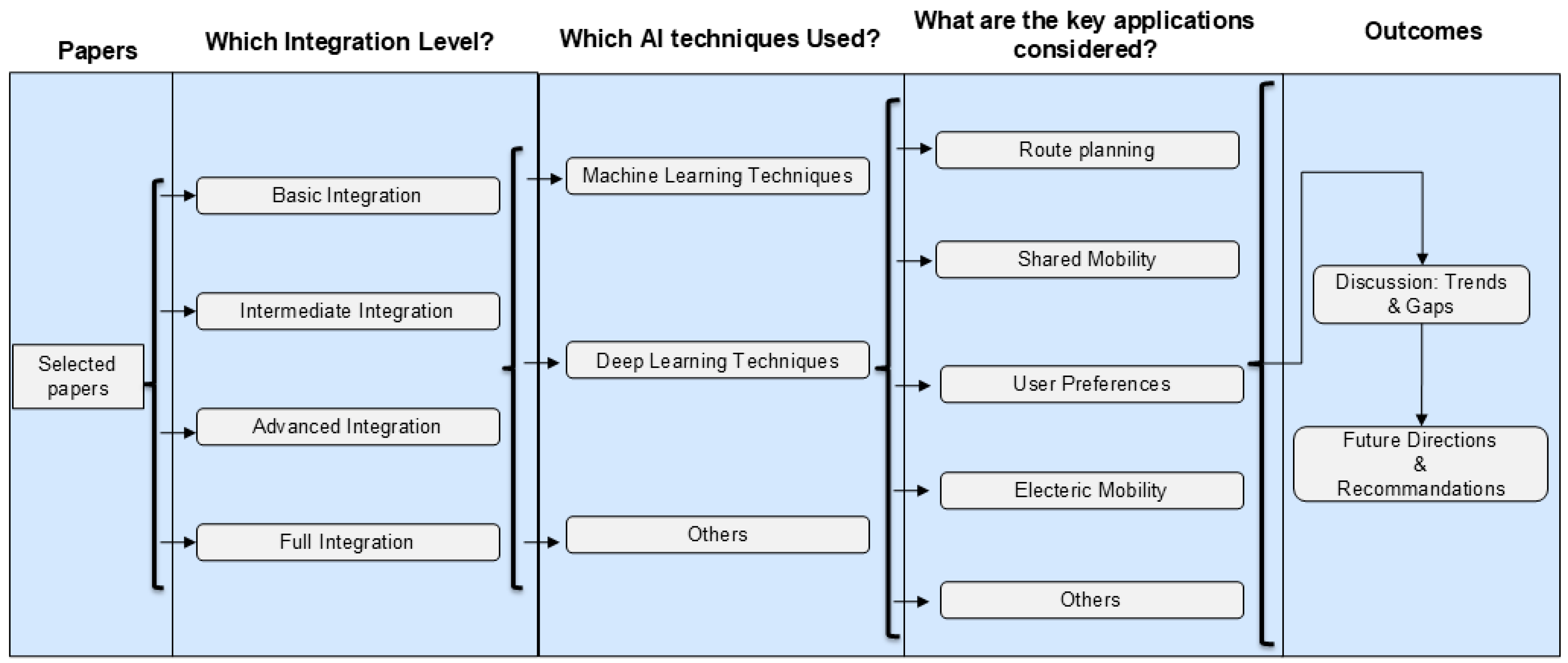
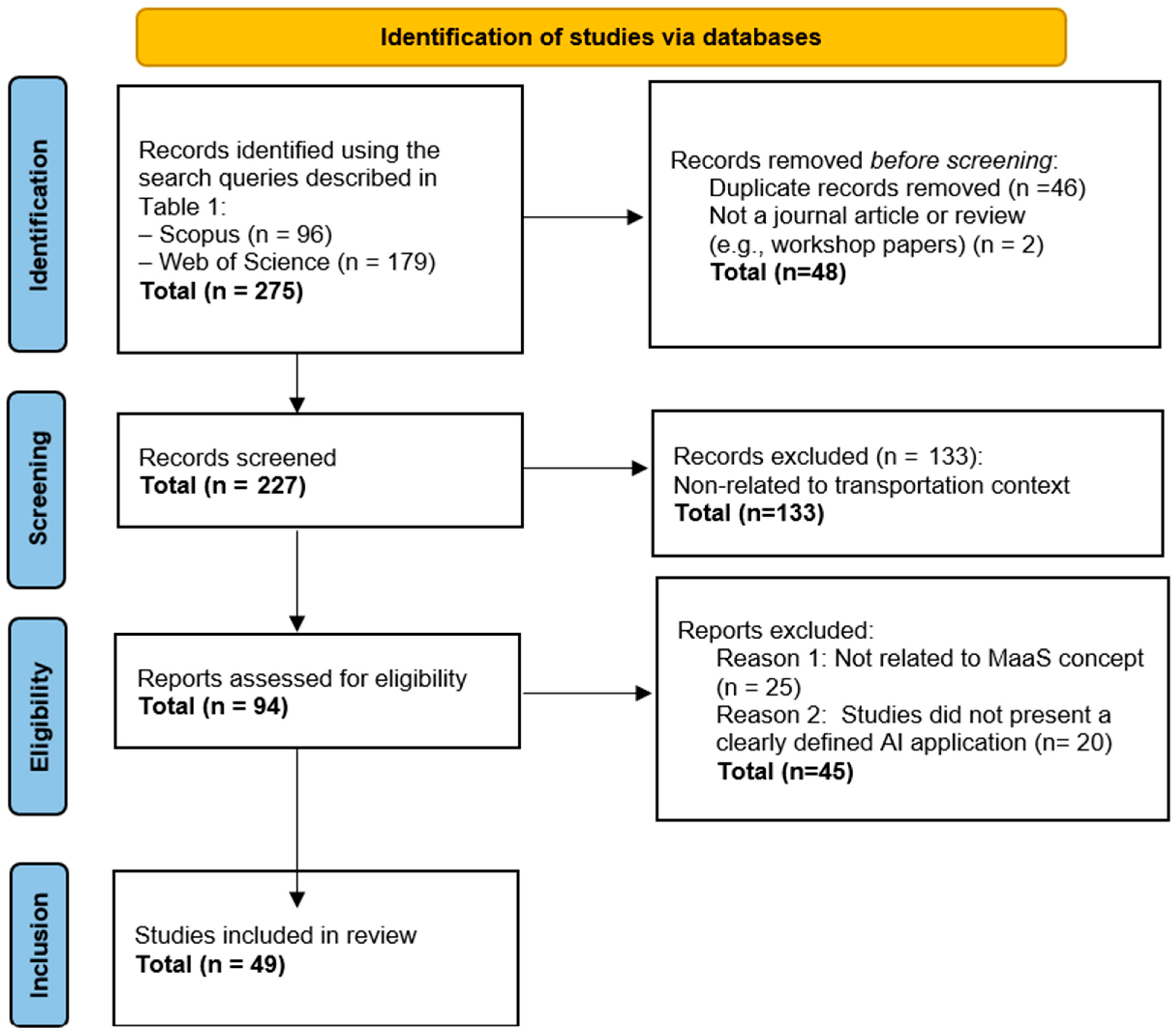

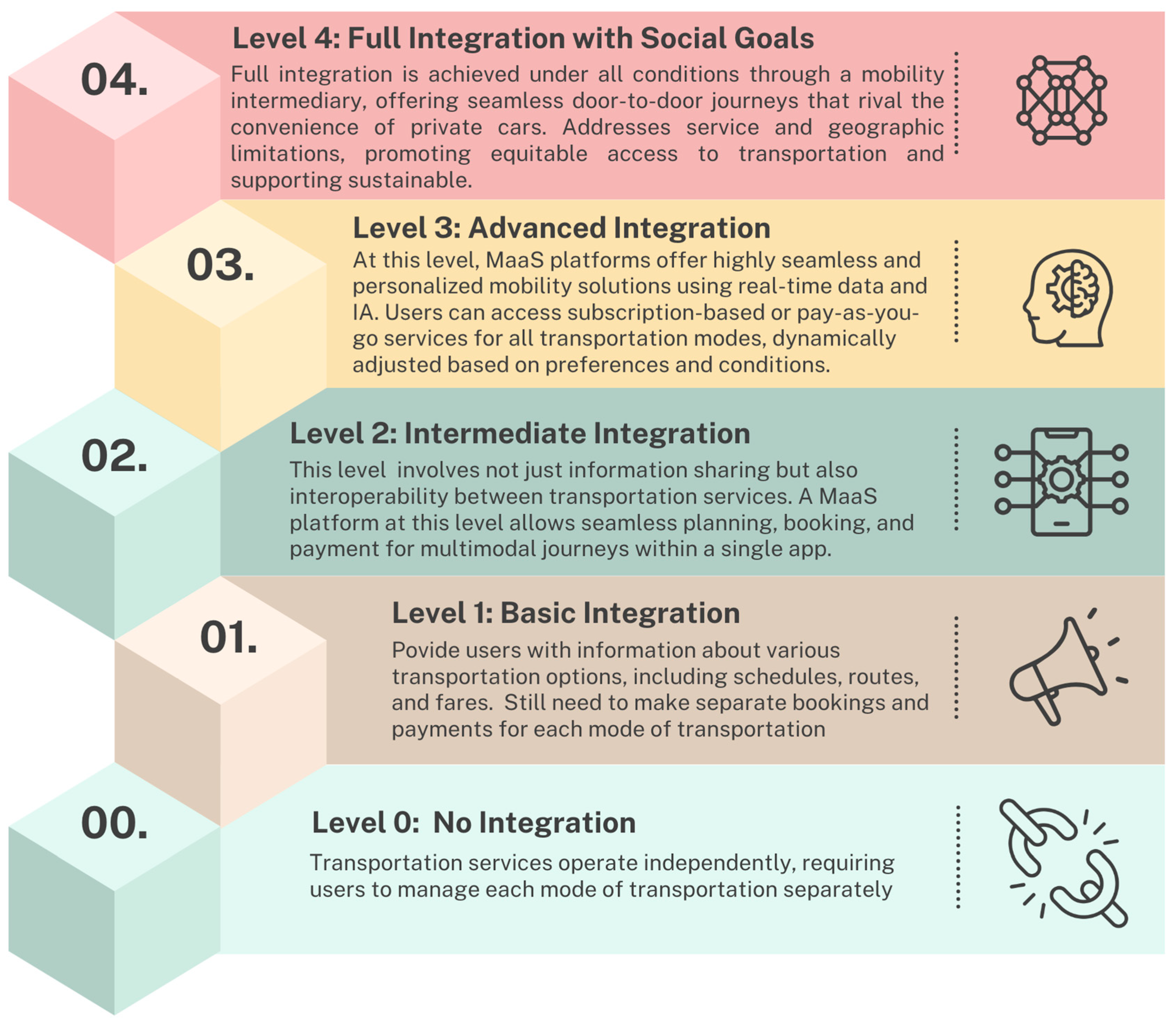
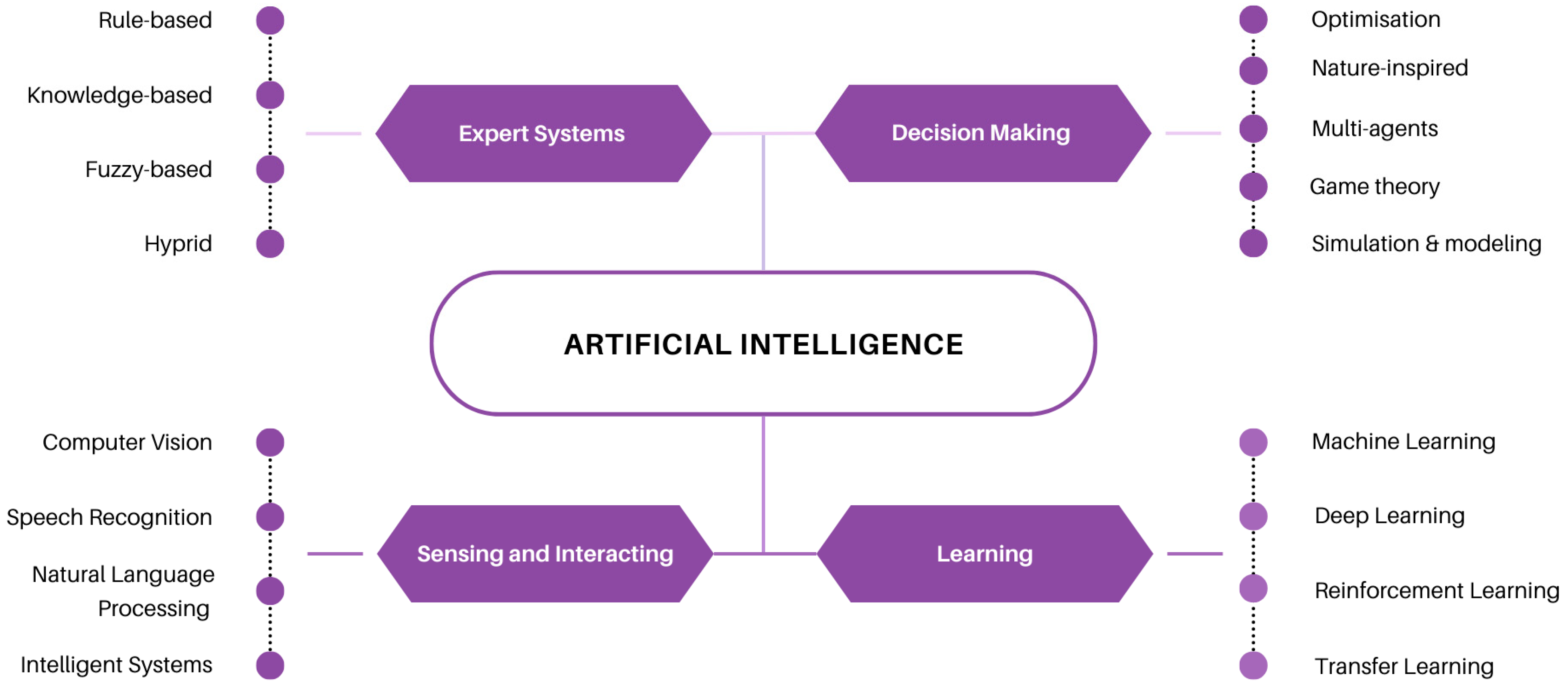

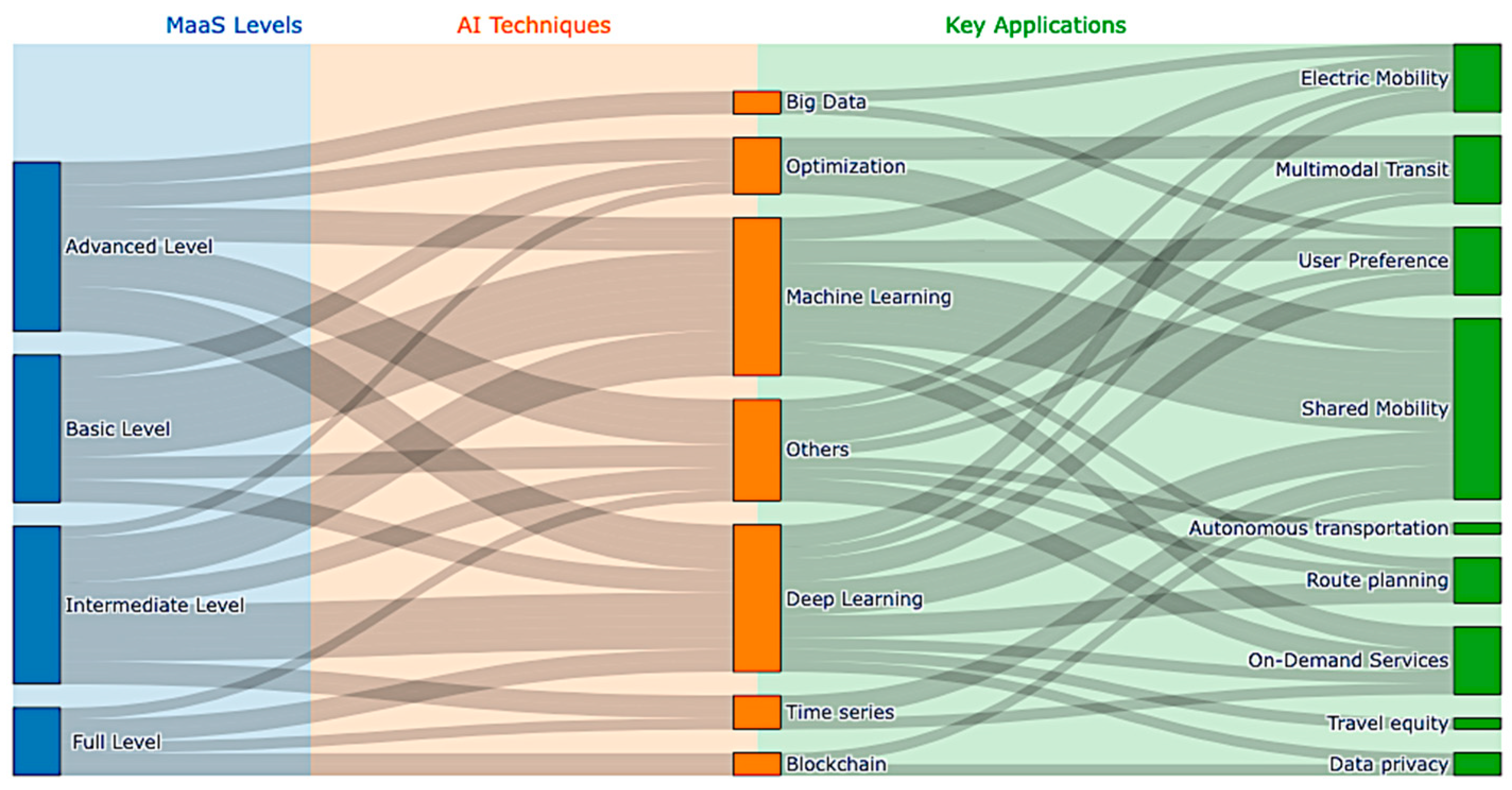
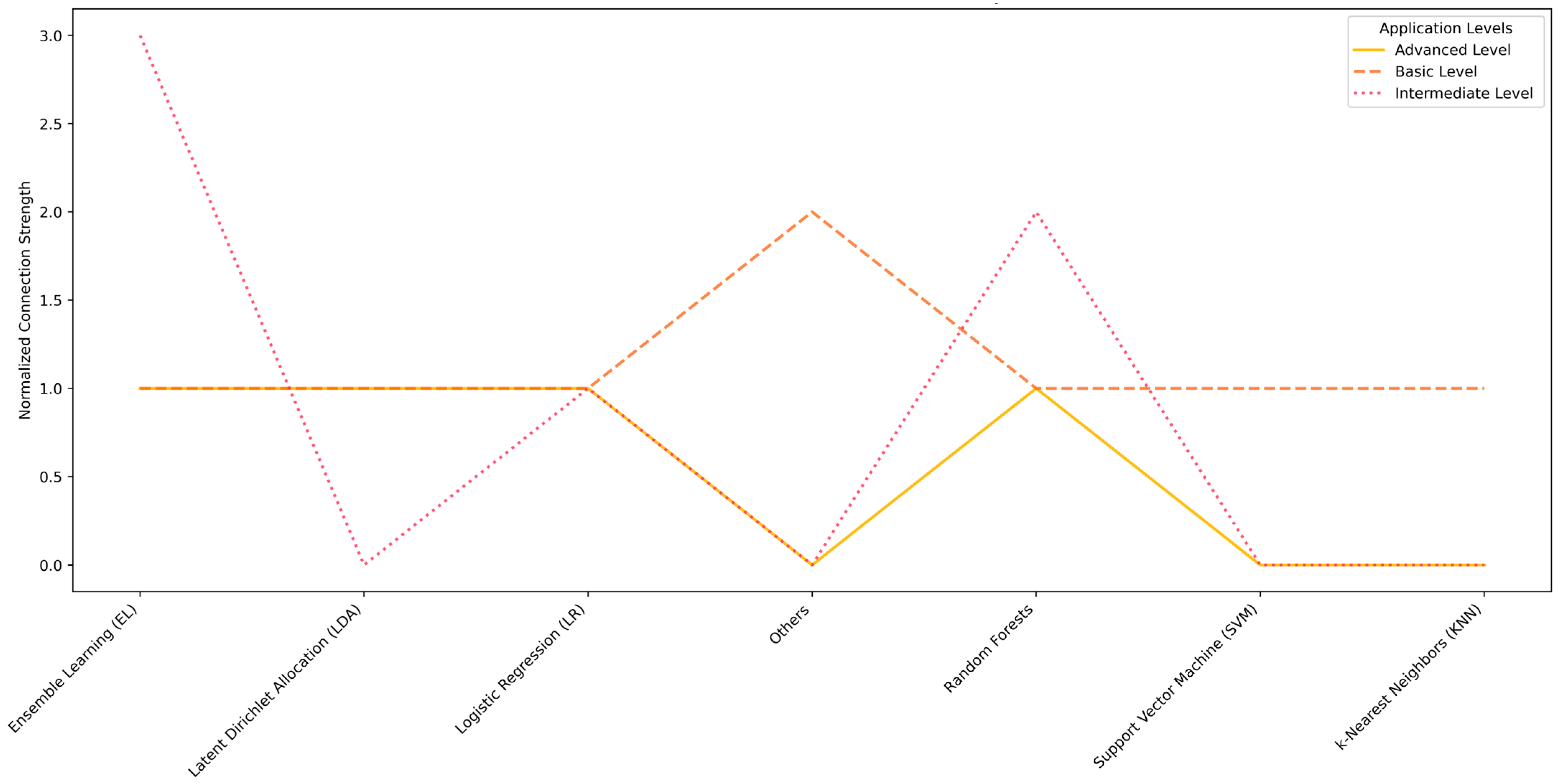
| Database | Search Query | Filters Applied |
|---|---|---|
| Scopus | TITLE-ABS-KEY ((“Mobility as a Service” OR “MaaS” OR “Mobility Service”) AND (“machine learning” OR “neural network” OR “artificial intelligence” OR “big data” OR “deep learning”)) AND (LIMIT-TO (PUBYEAR, 2024) OR LIMIT-TO (PUBYEAR, 2023) OR LIMIT-TO (PUBYEAR, 2022) OR LIMIT-TO (PUBYEAR, 2021) OR LIMIT-TO (PUBYEAR, 2020)) AND (LIMIT-TO (DOCTYPE, “ar”) OR LIMIT-TO (DOCTYPE, “re”)) | Years: 2020–2024; Document Type: Article, Review |
| Web of Science | TS = ((“Mobility as a Service” OR “MaaS” OR “Mobility Service”) AND (“machine learning” OR “neural network” OR “artificial intelligence” OR “big data” OR “deep learning”)) AND PY = (2020 OR 2021 OR 2022 OR 2023 OR 2024) AND (DT = “Article” OR DT = “Review”) | Years: 2020–2024; Document Type: Article, Review |
| No. | Paper | No. | Paper |
|---|---|---|---|
| A1 | Anthony Jnr et al. (2020) [15] | A26 | Malik et al. (2022) [16] |
| A2 | Cohen and Jones (2020) [17] | A27 | Panichpapiboon and Khunsri (2022) [18] |
| A3 | Longhi and Nanni (2020) [19] | A28 | Sun and Song (2022) [20] |
| A4 | Tempelmeier et al. (2020) [21] | A29 | Tu et al. (2022) [22] |
| A5 | Yoon and Chow (2020) [23] | A30 | Vitetta (2022) [24] |
| A6 | Alsaleh and Farooq (2021) [25] | A31 | Yang et al. (2022) [26] |
| A7 | Hüttel et al. (2021) [27] | A32 | You et al. (2022) [28] |
| A8 | Kong et al. (2021) [29] | A33 | Cao et al. (2023) [30] |
| A9 | Li et al. (2021) [31] | A34 | Chu et al. (2023) [32] |
| A10 | Luo et al. (2021) [33] | A35 | Ding et al. (2023) [34] |
| A11 | Miyake and Nishida (2021) [35] | A36 | Esztergár-Kiss (2023) [36] |
| A12 | Park and Hwang (2021) [37] | A37 | Fabiani et al. (2023) [38] |
| A13 | Phithakkitnukooon et al. (2021) [39] | A38 | Jian et al. (2023) [40] |
| A14 | R. Wang et al. (2021) [41] | A39 | Liang et al. (2023) [42] |
| A15 | X. Wang et al. (2021) [43] | A40 | Martin et al. (2023) [44] |
| A16 | Aman and Smith-Colin (2022) [45] | A41 | Rajabi et al. (2023) [46] |
| A17 | Boonjubut and Hasegawa (2022) [47] | A42 | Servou et al. (2023) [48] |
| A18 | Cheng et al. (2022) [49] | A43 | Turno and Yatskiv (2023) [50] |
| A19 | Choi et al. (2022) [51] | A44 | Zhang et al. (2023) [52] |
| A20 | Cokyasar et al. (2022) [53] | A45 | Zou et al. (2023) [54] |
| A21 | Cuomo et al. (2022) [55] | A46 | Chu and Guo (2024) [56] |
| A22 | Duan et al. (2022) [57] | A47 | Ibrahim et al. (2024) [58] |
| A23 | Lee and Kim (2022) [59] | A48 | Jianing et al. (2024) [60] |
| A24 | Lee et al. (2022) [61] | A49 | Sun et al. (2024) [62] |
| A25 | Li et al. (2022) [63] |
| Description | Results |
|---|---|
| Timespan | 2020–2024 |
| Documents | 49 |
| Average citation per doc | 7.02 |
| References | 392 |
| Document contents | |
| Keywords Plus (ID) | 452 |
| Author’s Keywords (DE) | 228 |
| Authors | |
| Authors | 176 |
| Authors of single-authored docs | 2 |
| Author collaborations | |
| Single-authored docs | 2 |
| Co-Authors per Doc | 3.92 |
| Words | Occurrence | Words in Titles | Occurrence | Words in Abstracts | Occurrence |
|---|---|---|---|---|---|
| deep learning | 10 | demand forecasting | 4 | shared mobility services | 6 |
| mobility service | 10 | deep reinforcement | 3 | passenger transport hub | 5 |
| mobility | 6 | mobility service | 3 | hybrid forecasting model | 4 |
| artificial intelligence | 5 | mobility services | 3 | artificial intelligence | 3 |
| big data | 5 | reinforcement learning | 3 | artificial neural network | 3 |
| Paper Reference | Paper Aims | AI Techniques | Key Applications |
|---|---|---|---|
| Tempelmeier et al. [21] | To Study the spatial and temporal impact of large-scale events on urban road traffic and assist in route planning management. | Machine Learning: Support Vector Regression (SVR), k-Nearest Neighbors (KNN), and Ridge Regression | Route planning |
| Luo et al. [33] | To optimize the deployment of shared electric mobility (e-mobility) systems across urban areas. | Deep Learning: Graph Convolutional Networks (GCN) Multi-agent deep reinforcement learning (MARL) | Electric Mobility, Shared Mobility |
| R. Wang et al. [41] | To propose a two-phase matching model for integrating taxi-sharing and subways into a sustainable multimodal transit system | Optimization | Route planning, Multimodal Transit, Shared mobility |
| X. Wang at al. [43] | To develop a regression model with spatially varying coefficients to understand how factors like land-use, social demographics, and transportation infrastructure affect bike-sharing demand at individual stations. | Machine Learning: Spatially Varying Coefficients (SVC), Random Forests, Support Vector Machines (SVM) | Shared mobility |
| Choi et al. [51] | To analyze shared mobility services in South Korea and evaluate the social opportunity cost of the ban on these services | Machine Learning: Multinomial logit | Shared mobility |
| Lee et al. [59] | Enhancing first and last-mile transportation in urban areas, particularly in Seoul by optimizing the placement of shared PMs, such as bicycles and scooters, | Machine Learning: Random Forest (RF), Extreme Gradient Boosting (XGB) | Shared mobility |
| Panichpapiboon and Khunsri [18] | Analyzing mobility patterns and evaluating the efficiency of taxi services | Statistical models: lognormal, gamma, and Weibull distributions | On-Demand Services |
| Yang et al. [26] | Optimize the relocation strategies of competing carsharing companies. | Optimization: Bilevel optimization | Shared mobility |
| Liang et al. [42] | To develop a supply and demand matching model for transportation modes in a Mobility-as-a-Service (MaaS) | Deep learning | Route planning |
| Zhang et al. [52] | Optimizing route planning within ride-hailing services | Deep Learning: Graph Attention Network | On-Demand Services, Route planning |
| Zou et al. [54] | Explores whether ride-hailing can compensate for the lack of public transportation services (PTS) in suburban new towns in China | Machine Learning: Geographically Weighted Regression (GWR) | On-Demand Services |
| Paper Reference | Paper Aims | AI Techniques | Key Applications |
|---|---|---|---|
| Yoon et al. [23] | To develop a revenue management strategy for bike-share systems | Machine Learning: Bootstrap, Multinomial Logit (MNL) | Shared mobility |
| Alsaleh and Farooq [25] | To develop trip production and distribution models for On-Demand Transit (ODT) services. | Machine Learning: Random Forests Ensemble learning: Baging Deep Learning with Explainability (SHAP) | On-Demand Services |
| Li et al. [63] | to predict short-term bicycle usage in bike-sharing systems. | Deep Learning: Spatial-Temporal Memory Network (STMN), Convolutional Long Short-Term Memory (Conv-LSTM), | Shared mobility |
| Park and Hwang [37] | To predict micro mobility demand and make decisions on bike relocations to improve service availability; | Deep Learning: Long Short-Term Memory (LSTM), Nature-inspired: Genetic Algorithm (GA) | Shared mobility |
| Phithakkitnukooon et al. [39] | Predicting Spatiotemporal Demand of Dockless E-Scooter Sharing Service | Deep Learning: Masked Fully Convolutional Network (MFCN) | Electric Mobility, Shared mobility |
| Boonjubut and Hasegawa [47] | To enhance bike distribution and availability in a bike-sharing network. | Time Series: ARIMA Deep Learning: Long Short-Term Memory (LSTM), and Recurrent Neural Networks (RNN) | Shared mobility |
| Cheng et al. [49] | To estimate the latent car-sharing demand at stations. | Time Series: Spatio-Temporal Autoregressive Moving Average (STARMA)) Machine Learning: Random Forests Ensemble learning: XGBoost | Shared mobility |
| Lee and Kim [59] | Enhance the operational efficiency of bike-sharing services by optimizing bike-sharing demand forecasts using data-driven approaches | Deep Learning: Recurrent Neural Network (RNN), Long Short-Term Memory (LSTM), Convolutional Neural Network (CNN), Convolutional LSTM (Conv-LSTM) and Graph Convolutional Network (GCN). | Shared mobility |
| Sun and Song [20] | Simulate individual traffic agents (vehicles) and optimize their timetables through a reservation system. | Simulation Agent-Based Models (ABM) | Route planning |
| Fabiani et al. [38] | handle competition among firms and reduce traffic congestion | Game Theory: Nash equilibrium seeking algorithm | On-Demand Services |
| Paper Reference | Paper Aims | AI Techniques | Key Applications |
|---|---|---|---|
| Anthony et al. [15] | To propose a multi-tier big data architecture to support the usage of Electric Mobility as a Service (eMaaS) within smart cities. | -Big Data tools: Spark and Hadoop | Electric Mobility |
| Longhi and Nanni [19] | To explore how data from car telematics can be used to develop advanced mobility services. | -Machine Learning: Random Forests -Ensemble learning: XGBoost -Deep Learning: Individual Mobility Networks (IMNs)) | Car insurance, Electric mobility, Shared mobility |
| Huüttel et al. [27] | To model latent demand for shared mobility services, such as bike-sharing and electric vehicles (EVs). | -Deep Learning: LSTM, CQNN, Multi-CQNN | Electric Mobility, Shared mobility |
| Aman and Smith-Colin [45] | To explore the factors that influence user satisfaction with advanced MaaS platforms | Machine Learning: Latent Dirichlet Allocation (LDA), Ordinal Logistic Regression (OLR) | Users Experience |
| Cokyasar et al. [53] | to propose a data-driven approach to improve the traveler experience within integrated mobility services | -Big Data Analytics -Recommender System | User Experience |
| Duan et al. [57] | to develop and test models to predict MaaS use for different trip categories and predict the likelihood of users adopting MaaS for different trip types (social, general, and work trips) | Deep Learning: | User Preference (Experience) |
| Malik et al. [16] | Select safer routes for bicycle riders based on real-time traffic, environmental conditions, and rider-specific characteristics. | Deep Learning: | Shared mobility, User Preference |
| Tu et al. [22] | improve the efficiency of railway passenger transport hubs by offering dynamic dispatching and real-time scheduling of transport services, offering more personalized and efficient mobility solutions for passengers at railway hubs. | -Fuzzy logic -Deep Learning -Optimization: dynamic weight scheduling algorithm | User Preference (Experience), Multimodal Transit |
| Chu et al. [32] | balance both passenger satisfaction and transport operator profit, ensuring proportional fairness across multiple transportation providers. | Reinforcement Learning | User Preference, Multimodal Transit |
| Ding, et al. [34] | dynamic pricing and resource allocation mechanisms that optimize services based on real-time user demand, preferences aspects. | Optimization: Vickrey-Clarke-Groves model, column-generation algorithm | User Preference, Shared mobility |
| Martin et al. [44] | identify user groups with similar mobility behaviors. | Machine Learning: Clustering Algorithms | User Preference |
| Rajabi et al. [46] | provide personalized mobility services in a MaaS context | Knowledge-based system | User Preference |
| Ibrahim et al. [58] | focuses on integrating autonomous vehicle systems with real-time urban transport solutions to promote sustainability within smart cities | Fuzzy logic | Autonomous transportation |
| Paper Reference | Paper Aims | AI Techniques | Key Applications |
|---|---|---|---|
| Kong et al. [29] | To ensure secure data aggregation and verifiable sharing of driver performance records among mutually independent MaaS operators while protecting user privacy. | Blockchain and cryptographic techniques: Proof-of-Stake (PoS) consensus, Paillier cryptosystem, and Bloom filters | monitoring system, Shared mobility |
| Miyake and Nishida [35] | To integrate AI-driven mobility solutions, such as AI Taxi and AI Bus, to improve urban transportation efficiency and enhance user experience. | Time Series: Multivariate autoregressive models Deep learning Ensemble Learning: XGBoost | On-Demand Services |
| Chu and Guo [56] | describes a highly integrated system that optimizes passenger satisfaction and MaaS long-term profit while ensuring data privacy, preventing information leakage and inference in a centralized MaaS platform | -Federated Learning -Reinforcement Learning | User Preference, Multimodal Transit |
| Jian et al. [40] | provides seamless and personalized travel options using real-time data and advanced algorithms, combining multiple transit modes while protecting user privacy. | Deep Learning: Convolutional Neural Network (CNN) -Federated Learning | User Preference, data privacy, Autonomous transportation |
| Jianing et al. (2024) [60] | predict travel mode usage across various demographics and assesses the effects of equity constraints on system efficiency, emissions, and MaaS platform profitability. The study also investigates the influence of pre-MaaS travel patterns on post-MaaS behaviors. | Deep Learning: Neural Networks (NN) with Shapley Additive Explanations (SHAP) | User Preference, travel equity |
Disclaimer/Publisher’s Note: The statements, opinions and data contained in all publications are solely those of the individual author(s) and contributor(s) and not of MDPI and/or the editor(s). MDPI and/or the editor(s) disclaim responsibility for any injury to people or property resulting from any ideas, methods, instructions or products referred to in the content. |
© 2025 by the authors. Licensee MDPI, Basel, Switzerland. This article is an open access article distributed under the terms and conditions of the Creative Commons Attribution (CC BY) license (https://creativecommons.org/licenses/by/4.0/).
Share and Cite
Rouky, N.; Benmoussa, O.; Fri, M.; Abourraja, M.N.; Ben-Bouazza, F.-E. Artificial Intelligence Applications for Smart and Sustainable Mobility as a Service Concept: A Systematic Literature Review. Future Transp. 2025, 5, 122. https://doi.org/10.3390/futuretransp5030122
Rouky N, Benmoussa O, Fri M, Abourraja MN, Ben-Bouazza F-E. Artificial Intelligence Applications for Smart and Sustainable Mobility as a Service Concept: A Systematic Literature Review. Future Transportation. 2025; 5(3):122. https://doi.org/10.3390/futuretransp5030122
Chicago/Turabian StyleRouky, Naoufal, Othmane Benmoussa, Mouhsene Fri, Mohamed Nezar Abourraja, and Fatima-Ezzahraa Ben-Bouazza. 2025. "Artificial Intelligence Applications for Smart and Sustainable Mobility as a Service Concept: A Systematic Literature Review" Future Transportation 5, no. 3: 122. https://doi.org/10.3390/futuretransp5030122
APA StyleRouky, N., Benmoussa, O., Fri, M., Abourraja, M. N., & Ben-Bouazza, F.-E. (2025). Artificial Intelligence Applications for Smart and Sustainable Mobility as a Service Concept: A Systematic Literature Review. Future Transportation, 5(3), 122. https://doi.org/10.3390/futuretransp5030122






